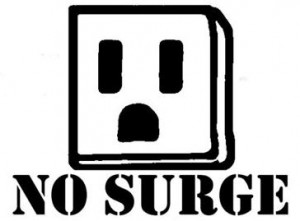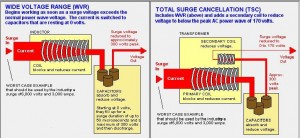SURGE PROTECTION (Secure the Security)
A surge protector also known as surge suppressor is an appliance designed to protect electrical devices from voltage spikes. A surge protector attempts to regulate the voltage supplied to an electric device by either blocking or by shorting to ground voltages above a safe threshold.
A power surge, or transient voltage, is an increase in voltage significantly above the designated level in a flow of electricity. If the surge or spike is high enough, it can inflict some heavy damage on a machine. A standard surge protector passes the electrical current along from the outlet to a number of electrical and electronic devices plugged into the power strip. If the voltage from the outlet rises above the accepted level — the surge protector diverts the extra electricity into the outlet’s grounding wire. Power surges occur when something boosts the electrical charge at some point in the power lines. This causes an increase in the electrical potential energy, which can increase the current flowing to your wall outlet.
Some of the specifications which define a surge protector for AC mains, as well as some communication protection, are:
- Clamping voltage – better known as the let-through voltage. This specifies what voltage will cause the metal oxide varistors (inside a protector to conduct electricity to the ground line. A lower clamping voltage indicates better protection, but a shorter life expectancy. The lowest three levels of protection defined in the UL rating are 330 V, 400 V and 500 V. The standard let-through voltage for 120 V AC devices is 330 volts.
- Joules – This number defines how much energy the surge protector can absorb without failure. A higher number indicates longer life expectancy because the device will divert more energy elsewhere and will absorb less energy. More joules conducting the same surge current means a reduced clamping voltage. Its often said that lower joule ratings is undersized protection since harmful spikes are significantly larger than this. Better protectors exceed 1000 joules and 40,000 amperes. If properly installed, for every joule absorbed by a protector, another 4 or 30 joules may be dissipated harmlessly into ground.
- Response time – Surge protectors don’t kick in immediately; a slight delay exists. The longer the response time the longer the connected equipment will be exposed to the surge. However, surges don’t happen immediately either. Surges usually take around a few microseconds to reach their peak voltage and a surge protector with a nanosecond response time would kick in fast enough to suppress the most damaging portion of the spike.
Principle:
Surge Protectors are very simple they let you plug multiple components into one power outlet. With all of the different components that make up a computer system, this is definitely a useful device.
Fig: Simple Surge Protector used in daily life.
Components:
1) Transient suppression diode.
2) Metal oxide varistor.
3) selenium voltage suppressor.
4) Gas discharge tube.
5) quarter-wave coaxial surge arrestor.
6) Carbon block spark gap overvoltage suppressor.
7) Series Mode surge suppressors.
Basic levels of power strip surge protectors:
1) Basic power strip.
2) Better power strip.
3) Surge station.
4) Uninterruptable power supply.










November 7th, 2010 at
Thank you……
I truly loved this page, appreciate sharing and also I have added your website for upcoming use….
May 9th, 2011 at
New Car Guide, Reviews & Pricing, Auto News for New Models…
really this is a nice web thank you thanks admin good post super messege…